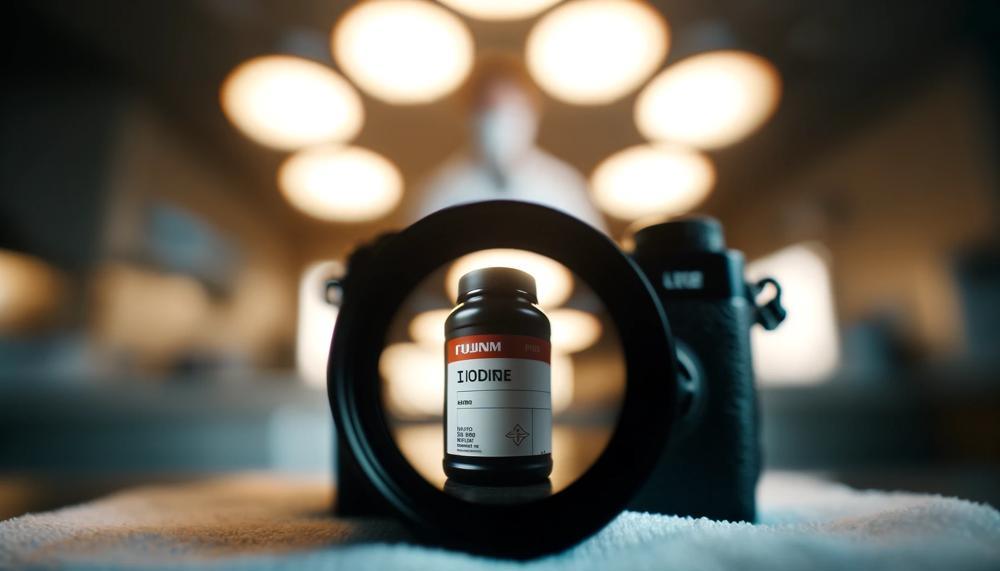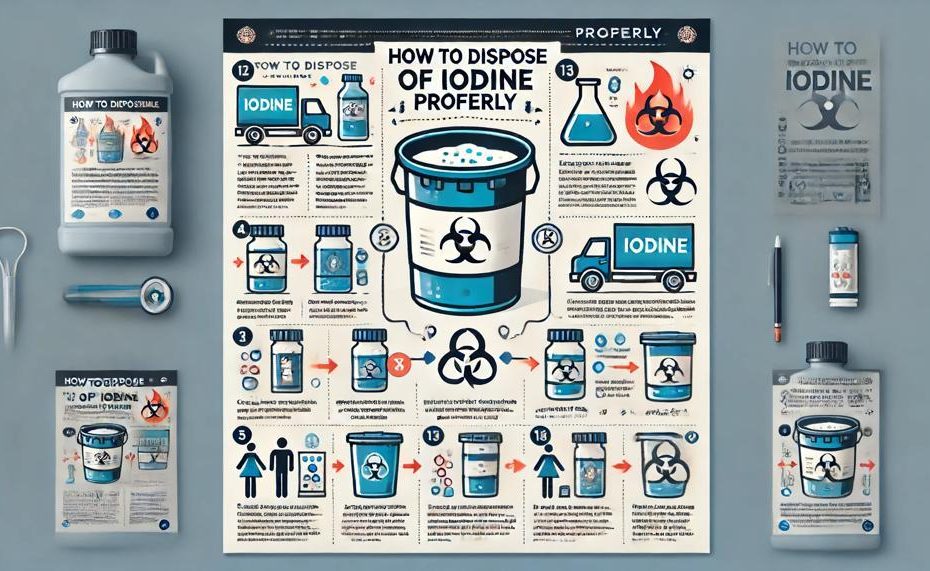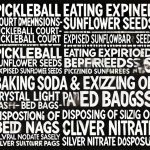Disposing of iodine may not be something we think about often, but getting it right is crucial for both our health and the environment. Improper disposal can lead to serious consequences, such as contamination of water sources and harm to aquatic life.
Imagine flushing iodine down the drain or tossing it in the trash, only for it to seep into the ground and disrupt the delicate ecosystems around us. So, what’s the right way to handle iodine disposal?
Here are some key points to keep in mind:
- Neutralize First: Neutralize acidic iodine solutions with sodium bisulfite or sodium thiosulfate.
- Dilution Matters: Dilute the neutralized solution with plenty of water to significantly reduce iodine concentration.
- Local Rules Apply: Check your local regulations to determine if you can safely pour the diluted solution down the drain or if it needs to go to a hazardous waste facility.
- Tablet Check: For iodine tablets, check their expiration date and discard any that are expired.
- Prevent Leaching: Crush expired tablets and mix them with an absorbent material like cat litter to prevent environmental leaching.
- Read the Label: Some iodine tinctures contain hazardous ingredients—always check the label for specific disposal instructions.
- Secure Packaging: If disposing of tinctures, transfer them from glass bottles to secure plastic containers.
- Seek Guidance: For tricky cases, reach out to your local hazardous waste facility for the best disposal practices.
Understanding and following these steps ensures we do our part in keeping our surroundings safe and healthy. So next time you need to dispose of iodine, remember these tips to handle it responsibly.
Contents
Official MSDS Guidelines
According to the Material Safety Data Sheet (MSDS), the official guidelines for disposing of iodine include diluting it with water and placing it in a sealed, labeled container before disposing of it in the garbage. It is important to always wear protective gear when handling iodine and to evacuate the area if necessary. In case of a spill, first moisten the iodine or use a HEPA-filter vacuum before placing it in sealed containers for disposal. Do not wash it into the sewer.
If you work with iodine regularly, you may be able to recycle or return unused iodine to the manufacturer for approved uses. Waste management companies may also have contacts for reusing iodine. However, if necessary, treat iodine as hazardous waste and contact state or federal agencies for specific recommendations.
It is important to note that different forms of iodine may have different disposal guidelines. For example, neutralize acidic iodine solution with sodium bisulfite or sodium thiosulfate before diluting it with a large amount of water. Check local regulations for appropriate disposal methods, such as pouring down the drain or taking it to a hazardous waste facility.
When disposing of expired iodine tablets, mix them with an absorbent material like cat litter to prevent leaching into the environment. For iodine tinctures, transfer them from glass bottles to secure plastic containers before disposal. It is also recommended to contact your local hazardous waste facility for guidance on disposing of iodine tinctures.
Disposal of Iodine Monochloride
Disposing of iodine monochloride safely is crucial to prevent environmental contamination and safeguard human health. Follow these steps for proper disposal:
- Personal Protective Equipment (PPE):
Always wear appropriate PPE, including gloves, safety goggles, and a lab coat, to avoid direct contact with iodine monochloride.
- Dilution:
Dilute iodine monochloride with a large volume of water. This reduces its reactivity and makes it safer to handle.
- Neutralisation:

Slowly add sodium thiosulfate to the diluted solution. Sodium thiosulfate neutralises iodine monochloride, converting it into less harmful substances.
- Containment:
Place the neutralised solution into a sturdy, sealed, and clearly labelled container. Ensure the container is leak-proof.
- Local Regulations:
Check with local hazardous waste facilities for specific disposal guidelines. Regulations can vary, and in some areas, hazardous waste facilities may be the only proper disposal method.
- Hazardous Waste Facility:
If required, transport the sealed container to a certified hazardous waste disposal facility. Contact them beforehand to confirm they can accept iodine monochloride waste.
- Documentation:
Keep records of the disposal process, including quantities and neutralisation steps. This documentation is often required by regulatory agencies.
- Consultation:
When in doubt, consult with a hazardous waste management professional or facility to ensure compliance with all local and federal regulations.
Other Recommendations for Disposal
Yes, there are specific disposal methods recommended for iodine waste beyond those mentioned earlier. Proper disposal of iodine waste is essential to prevent environmental contamination and ensure public safety. Here are additional methods:
- Solidification and Stabilization:
- Solidify iodine waste by mixing it with materials like cement, clay, or lime. This process reduces the waste’s mobility, making it safer to handle and dispose of in landfills.
- Incineration:
- For certain iodine compounds, incineration at high temperatures in a controlled environment can safely break down hazardous components. This method is typically used for organic iodine compounds, ensuring complete combustion and preventing toxic releases.
- Chemical Neutralization:
- Neutralize iodine solutions by adding reducing agents such as sodium thiosulfate or ascorbic acid. This chemical reaction converts iodine into non-toxic iodide, which can then be safely disposed of through wastewater treatment facilities.
- Activated Carbon Adsorption:
- Use activated carbon filters to adsorb iodine from aqueous solutions. This method is particularly useful for treating contaminated water. The saturated carbon can then be processed and disposed of according to hazardous waste regulations.
- Containment and Long-term Storage:
- For radioactive iodine isotopes, secure containment and long-term storage in designated facilities are necessary. This method ensures that radioactive decay occurs without posing a risk to the environment or public health.
- Return to Manufacturer:
- Some manufacturers offer take-back programs for unused or expired iodine products. Contact the manufacturer to see if they provide this service, which ensures proper handling and disposal.
Recycling
Incorporating recycling into the disposal of iodine can be a responsible and effective method to manage this potentially hazardous material. Here’s how recycling can be included in the proper disposal of iodine:
| Method | Description | Action Required |
| Recycling Glass Bottles | Transfer iodine to a plastic container; recycle the glass. | Rinse, dry, and place in glass recycling bin. |
| Recycling Containers | Plastic containers used for iodine solutions. | Clean and recycle according to local regulations. |
| Safe Disposal of Absorbent Material | Mix iodine with cat litter or sawdust. | Place in a recyclable, labelled container. |
| Hazardous Waste Facilities | Specialized recycling programs for hazardous waste. | Contact local facilities for specific guidelines. |
| Manufacturer Take-Back Programs | Return iodine products to the manufacturer for recycling. | Check if the manufacturer offers this service. |
| Educational Resources | Guidance from local authorities or environmental groups. | Follow detailed instructions for safe disposal and recycling. |
Disposal in the Case of Radioactive Iodine Treatment
Radioactive iodine, used in medical treatments, requires careful disposal due to its hazardous nature. Proper disposal ensures safety for individuals and the environment. Here’s how it should be handled:
| Disposal Method | Details | Important Notes |
|---|---|---|
| Sanitary Sewage System | Flush small amounts of radioactive iodine down the toilet. | Check local regulations to ensure compliance. |
| Sealed Containers | Place incompatible items in a sealed container. | Store in a secure, outside area for 1-2 months. |
| Municipal Solid Waste | Avoid this method; most waste streams are monitored for radioactivity. | You might trigger radioactivity detectors. |
Conclusion
Proper iodine disposal isn’t just a good practice—it’s a vital step in safeguarding both our health and the environment. Mishandling iodine can lead to severe consequences, such as water contamination and harm to aquatic life. To dispose of iodine correctly, follow these key steps:
- Neutralize and Dilute: First, neutralize acidic iodine solutions using sodium bisulfite or sodium thiosulfate. Then, dilute the neutralized solution with a substantial amount of water to reduce its concentration.
- Follow Local Regulations: Check your local disposal regulations. Depending on your area, you may be able to pour the diluted solution down the drain, or you might need to take it to a hazardous waste facility.
- Handle Tablets with Care: For expired iodine tablets, crush them and mix with an absorbent material like cat litter to prevent environmental leaching.
- Check Labels: Always read the labels on iodine tinctures for specific disposal instructions, as they may contain additional hazardous ingredients.
- Use Secure Packaging: Transfer tinctures from glass bottles to secure plastic containers to avoid breakage and spills during disposal.
- Consult Professionals: When in doubt, reach out to your local hazardous waste facility for guidance on the best disposal practices.
By following these steps, you ensure that iodine is disposed of safely, protecting our ecosystems and communities.





